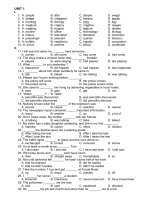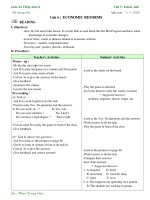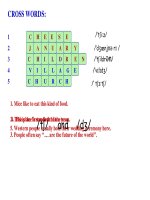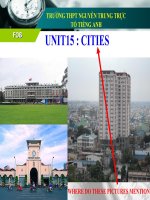English 10 - Unit 4
Bạn đang xem bản rút gọn của tài liệu. Xem và tải ngay bản đầy đủ của tài liệu tại đây (230.88 KB, 4 trang )
LESSON PLAN
Student teacher’s name: Trần Thị Hồng Liên
Class : 10
Time : 45 minutes
Lesson : Unit 4 SPECIAL EDUCATION
Reading (text on page 44 & 45)
Aims:
1. To introduce some basic knowledge about special education
2. To present vocabulary in the reading text
3. To help students understand the text and do all the tasks in the Pre, While and Post-Reading
Objectives: At the end of the lesson, students will be able to:
1. Know the way that the disabled people using to communicate
2. Acquire some basic knowledge about special education
3. Develop reading skills through tasks.
Approach and Teaching Aids/Materials:
• Communicative Approach
• Computer, handouts, board, chalks, textbook
Procedures:
A. Classroom procedure:
Greeting and Attendance check (1 minute)
B. New lesson:
Time Teacher’s activities Contents Student’s activities
15’ I. PRE-READING:
1. Warming up:
- Shows some pictures
about disabled people in
slide.
- For each slide, T asks sts
guessing the disability of
those.
2. Introducing the text:
- Introduces sts the Braille
- Pictures in slide
- What are they doing?
How are they?
- Why are they using their fingers?
How are they?
- The Braille Alphabet is showed on
- Look at the slide show
- Guess what disability of
the people is
- Participate in the game
1
15’
Alphabet.
- Shows the message.
- Gives feedback.
3. Presenting new
vocabulary:
- Requests sts to look at the
text.
- Shows the paper of new
words on the board.
DISABLED
+ Gives the meaning.
MENTALLY RETARDED
+ Gives the meaning.
TIME-CONSUMING
+ Gives the meaning.
DEMONSTRATION
+ Gives the meaning.
GRADUALLY
+ Gives the meaning.
II. WHILE-READING:
Then gives handouts and
lets all the sts read in
silence to finish the
computer screen.
PLAY A SMALL GAME
- Can you guess the message following?
The message is the title of our reading
lesson today: A TEACHER IN A
SPECIAL CLASS
- Disabled (adj): unable to use a part of
body properly
Disable (v)
Disability (n)
- Mentally retarded (adj): slower to
develop than normal in the mind.
- Time-consuming (adj): needing a lot of
time.
consume (v)
consumption (n)
- Demonstration (n): an act of explaining
how to do s.th
demonstrative (adj)
demonstrate (v)
- Gradually (adv): slowly, over a long
period of time.
gradual (adj)
- You have only 3 minutes to finish your
reading as well as task 1.
- Work out the message
- Look at the text.
- Listen
- Translate
- Take notes.
- Listen and look at the
screen.
- Take notes.
- Listen
- Give examples
- Take notes.
- Listen
- Translate
- Take notes.
- Listen.
- Take notes.
- Repeat all the new
words
- Read in silence.
2
14’
following tasks.
- Asks sts to match the new
words have been taught
with their definitions.
- Gives feedback.
- Asks sts to answer the
questions.
- Gives feedback.
- Asks sts to choose the
correct options by circling
the corresponding letter A,
B, C or D.
- Gives feedback.
- Asks sts to work in pair
for finishing the summary
of the reading text by filling
the blanks.
- Gives feedback.
III. POST-READING:
- Lets sts discuss the
problems of the deaf and
the mute and other disabled
people in their daily life and
how they overcome them.
- Gives some illustrations.
- Gives feedback.
Task 1: Matching the new words have
been taught with their meanings.
- Handout (see appendix)
Task 2: Answering the questions
belonging to the reading text.
- Handout (see appendix)
Task 3: Multiple-choice. Choose the
suitable corresponding based on the text.
- Handout (see appendix)
Task 4: Gap-filling. Summarize the
reading text by using the words in the text
to complete.
- Handout (see appendix)
Task 5: Discuss the topic
“What are the problems that
disabled people have to deal with in
their daily life? How do they
overcome them?”
- Do the task.
- Answer the given
questions.
- Complete the task and
explain why they choose
this option.
- Work in pair to
complete the task.
- Sit in four
- Do the task
- One S represents the
ideas of their group.
APPENDIX:
Task 1: The words in A appear in the reading passage. Match them with their definitions in B.
A B
1. disabled
2. mentally retarded
3. time-consuming
4. demonstration
5. gradually
a. taking or needing a lot of time
b. an act of showing or explaining how to do something
c. unable to use a part of the body in the normal way
d. slowly, over a long period of time
e. less mentally developed than normal
Answers: 1c, 2e, 3a, 4b, 5d
Task 2: Read the text again and answer the following questions:
1. How is Ms.Thuy’s class different from the others?
Her students are disabled. Some are deaf, some dumb and others mentally retarded.
2. Why did the parents of the students at first oppose her to teach their children?
Because they used to believe that their children could not learn anything at all.
3. What did the parents realize about Ms.Thuy?
The parents realized that the young teacher was making great efforts to help their poor kids.
4. What did she do to teach the children learning how to add and subtract in the Maths class?
During the Maths lesson, she raised both arms and opened up her fingers one by one until all ten stood
up. She then closed the fingers one by one. She continued the demonstration until the children realized they
had just learned how to add and subtract.
3
5. How do her students feel afterward?
They are proud of their efforts.
Task 3: Read the passage again and complete the following sentences by circling the corresponding letter
A, B, C or D
1. Thuy’s class is different from other classes because the children…..
A. are from large families.
B. are less mentally developed.
C. love Maths very much.
D. are disabled.
2. At first the parents were…the ideas of sending their children to the special class.
A. interested in
B. opposed to
C. satisfied with
D. worried about
3. It can be inferred from the 2nd paragraph of the reading passage that there has been….
A. a change in the parents’ attitude towards the class.
B. a lot of protest from the parents against the class.
C. a feeling of doubt in the teacher’s ability.
D. a belief in the parents’ opposition.
4. The writer describes how Thuy teaches the children to add and subtract in order to prove that…..
A. the children like Maths.
B. the teacher is a proud of her work.
C. the teaching work takes time.
D. adding and subtracting are important.
5. The writer’s attitude towards Thuy’s work in the passage can be described as……
A. humorous
B. angry
C. suspicious
D. admiring
Answers: 1d, 2b, 3a, 4c, 5d
Task 4: Fill each of the blanks of the summary below with a suitable word from the reading text:
Twenty-five………children have the chance of learning how to…………and………thanks to the
…………..of a young teacher, Pham Thu Thuy. Although her idea, at first, met with………….from the
parents of the disabled children, more children attended her class later. The teaching work in the special
class is……….…………..For example, in a………..lesson, the teacher has to use her…………...and
…………..to teach the children how to add and subtract. The children are now ………..and happy.
Answers:
1. disabled
2. read
3. write
4. efforts
5. opposition
6. time-consuming
7. Maths
8. arms
9. fingers
10. proud
4









